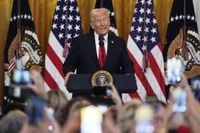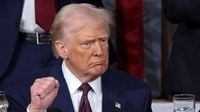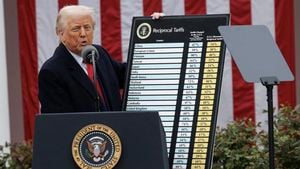On April 2, 2025, President Donald Trump is poised to announce a series of "reciprocal" tariffs that could reshape the landscape of international trade and significantly impact the U.S. economy. Dubbed "Liberation Day" by Trump, the tariffs aim to bolster American manufacturing and penalize countries he claims have engaged in unfair trade practices.
The White House has been promoting this announcement for weeks, generating both anticipation and anxiety among businesses and consumers alike. White House Press Secretary Karoline Leavitt declared, "April 2, 2025, will go down as one of the most important days in modern American history," emphasizing that the tariffs would take effect immediately.
This new wave of tariffs follows recent measures, including a 25% tax on auto imports and expanded tariffs on steel and aluminum. Trump has also indicated plans for tariffs against nations importing oil from Venezuela, as well as separate levies on pharmaceutical drugs, lumber, copper, and computer chips.
Trade adviser Peter Navarro has suggested that the tariffs could generate $600 billion annually, marking the most significant tax increase since World War II. However, economic experts are warning that the ambitious plan could backfire, leading to a downturn in the economy and straining long-standing international alliances.
The Budget Lab at Yale University estimates that a universal 20% tariff could cost the average American household between $3,400 and $4,200. Many economists predict that the tariffs will stifle economic growth, potentially reducing the U.S. GDP by about one percentage point. As a result, everyday items like clothing, oil, and groceries could become more expensive.
Despite these warnings, the administration remains optimistic, asserting that the tariffs will incentivize manufacturers to ramp up domestic production and create new jobs. Leavitt expressed confidence, stating, "They’re not going to be wrong. It is going to work. And the president has a brilliant team of advisers who have been studying these issues for decades." However, many remain skeptical.
Critics within the Democratic Party, including Senate Leader Chuck Schumer, argue that the tariffs are primarily a strategy for Trump to fund tax cuts benefiting the wealthy. Schumer stated, "Almost everything they do, including tariffs, it seems to me, is aimed at getting those tax cuts for the wealthy." Even some Republicans have acknowledged the potential for disruption in an otherwise healthy economy, with House Speaker Mike Johnson noting, "It may be rocky in the beginning. But I think that this will make sense for Americans and help all Americans."
Internationally, longstanding allies are preparing to respond. Canada has already implemented countermeasures against U.S. tariffs, particularly those linked to fentanyl trafficking. Meanwhile, the European Union has retaliated with tariffs on $28 billion worth of U.S. goods, including bourbon, prompting Trump to threaten a staggering 200% tariff on European alcohol.
As uncertainty looms, Ray Sparnaay, general manager of JE Fixture & Tool in Canada, expressed concern about the negative impact of the impending tariffs on business operations. "There’s going to be tariffs implemented. We just don’t know at this point," he said. "It’s basically slowed all of our quoting processes, business that we hope to secure has been stalled."
In addition to the tariffs, stock markets are reacting with caution. Futures tied to the S&P 500 and Nasdaq-100 have slipped, reflecting investor anxiety ahead of the announcement. The Dow Jones Industrial Average futures were down 121 points, or 0.3%. This volatility follows a chaotic trading day where the S&P 500 managed to finish about 0.4% higher, while the Nasdaq Composite rose roughly 0.9%.
Amidst these developments, analysts are also keeping an eye on the ADP employment report, which is expected to show a rise in private sector jobs. Economists anticipate that 120,000 jobs were added in March, up from 77,000 in February.
Back in India, the implications of Trump's tariff strategy are being closely monitored. Economists warn that India could face a $6–7 billion loss in exports to the U.S. if broad-based reciprocal tariffs are enforced, potentially resulting in a slight dip of 0.1% to 0.2% in GDP. This could lead to increased market volatility and uncertainty in global trade.
As nations brace for the fallout, India's crude oil imports from the U.S. have surged by 67% in March 2025, reaching 244,000 barrels per day. This increase suggests that Trump's efforts to boost American oil sales are having an impact, even as India also ramps up imports from Russia.
In a related note, the solar glass manufacturer Borosil Renewables in Mumbai remains optimistic about benefiting from selective tariffs on Chinese imports. Chairman Pradeep Kheruka stated, "If similar tariffs are imposed on India and China, then we are at par with China. In case they are imposed selectively on China, then we stand to gain."
As the world watches closely, the economic landscape is shifting dramatically. Trump's tariffs signal a return to protectionist policies that could redefine global trade dynamics. The coming days will reveal the full impact of these measures as countries respond and adjust their strategies.






